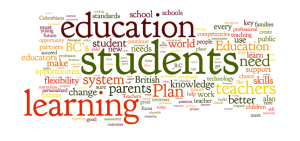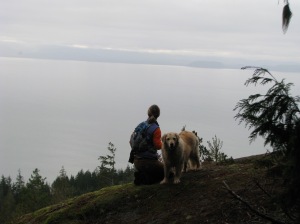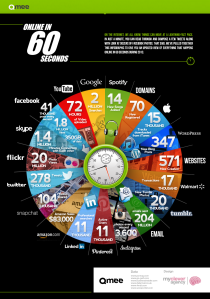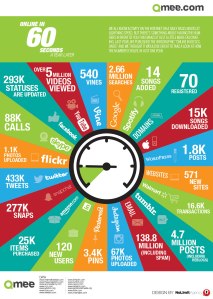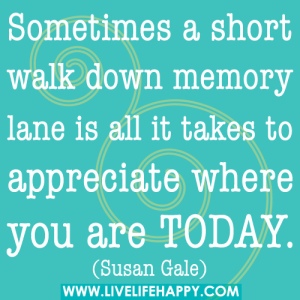One chapter from Clive Thompson’s book Smarter Than You Think that brought about a vigorous discussion was Chapter 4: The New Literacies. Many teachers have used Wordle or have seen it used. Wordle creates a cloud of words by sifting through a selection of text. Frequently used words appear larger than words that appear less often. In my school, several teachers use it to sort key ideas in class discussions or to generate or organize ideas for student writing. A great idea from Bryan Jackson at the start of this term as we were working towards solidifying our Masters project topics was to drop all of our Masters blog posts into Wordle to help us visualize where our focus might actually lie. If we hadn’t lost our blogs in a security breach over the summer, this idea would have helped many of us!
The author shared a way that Wordle was used during the 2008 American Presidential election, where people used Wordle to find the big themes in campaign speeches. Wordle became a data analysis tool! This action revealed that one candidate was focusing on oil and energy and the other candidate’s main words were “children”, “Americans”, “make”, “care, and “need”. (Thompson, 2013) One possible president was sharing an urgent need to drill for oil as soon as possible and other contender had a more general focus addressing the needs of many.
Our book club was inspired by the idea of using Wordle to seek themes within text. Someone suggested that we take a look at the new BCEd Plan as viewed through Wordle. It is reassuring to see “students” at the heart of the plan! Wordle is not a perfect tool, as capitalized words or words with punctuation are recognized differently than the root words. However, overall, I believe that this word cloud represents the BCEd Plan fairly accurately.
I would really like to see particular words have a greater emphasis. For example, “personalized” is quite small, yet a lot of the language of teachers revolves around encouraging students to explore topics that they are passionate about in order to develop their skills as learners. “Interests” is about the same size as “personalized”, yet the two ideas feed each other to make learning more relevant for our students.
Another word that is missing emphasis for me is “authentic”. Teachers all over the province are striving to provide meaning for their students by providing real-world relevance to their learning experiences. In my opinion, “authentic” should appear quite heavily emphasized in this document, as the learning experiences and the assessment practices should be reflective of the opportunities that are available in this digital age. Students are constantly learning beyond the classroom and are finding strategies to learn what they want to know using the various tools that are available. Teachers are working to support students in developing digital literacies and smarter searching skills. Our assessment practices should be a source of feedback that feeds ongoing learning, supports further inquiry, and opens opportunities for more questions. In my experiences as a learner, authentic assessment has inspired more learning and conversations as opposed to ending my learning (for example, end of unit tests).
The document that accompanies the BCEd Plan is our new BC Curriculum, where we look at assessment through the lens of competency, yet the word “competencies” is very small in the actual Ed Plan document.
The Wordle reveals that the BCEd Plan slogan matches the text of the document: “Students must be at the centre of their learning”. “Students” are indeed at the centre of the Wordle, surrounded by “education” and “learning”. This document withstood the 2008 campaign speech test.
Using Wordle this way made me think about my own teaching practice. If I were to record my own words with my students for a week, what would the Wordle reveal? What words would be emphasized and what would that say about me? What bad habits do I have in my speaking? How is my tone? Wordle can force me to be honest about my word choice.
How have you used Wordle? What did you learn?
References:
Thompson, C., 1968. (2013). Smarter than you think: How technology is changing our minds for the better. New York: The Penguin Press.

